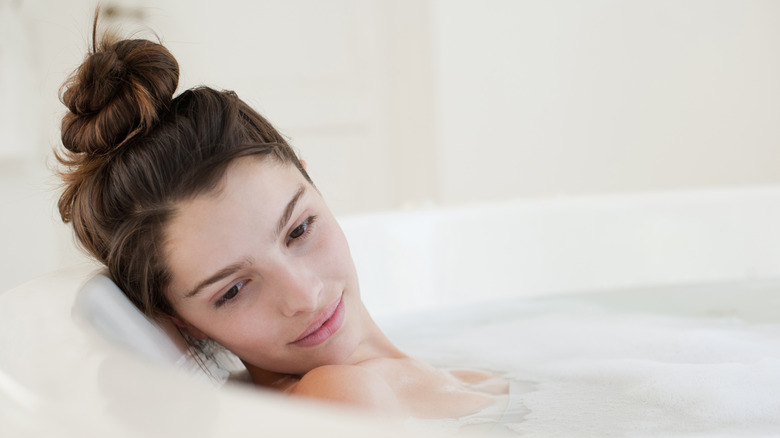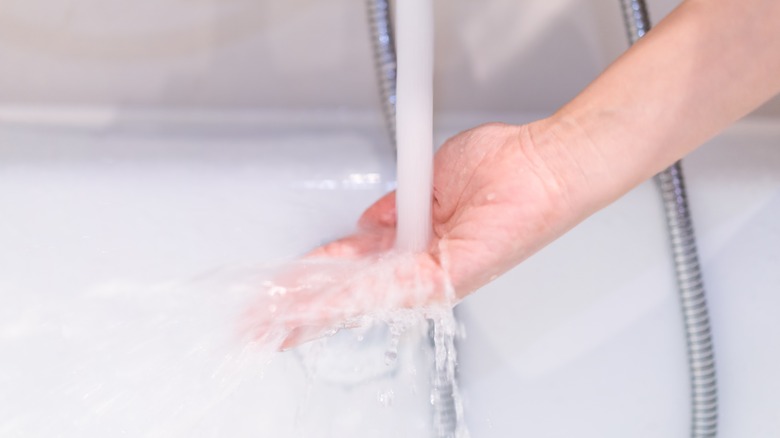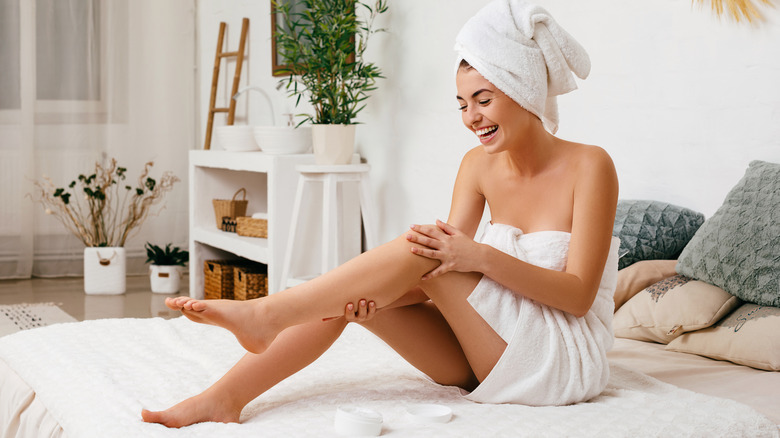A Bleach Bath Could Be The Eczema Treatment You Need
A bath can be a risky proposition when you have eczema. Hot water, fizzy bath bombs, and luxuriously scented bubbles typically spell trouble for those with either atopic dermatitis or eczema. Instead of leaving your skin smooth and supple, popular bath products and hot, sudsy water may irritate red, scaly, and painful patches. So, you're probably reading that headline and thinking: "You want me to add bleach to my bath?!"
Bleach is a strong disinfectant that many rely on as a household product to kill bacteria and viruses. Understandably, the idea of getting into a bathtub with bleach may put you on edge. However, bleach baths could actually help manage eczema flare-ups when done properly, providing much-needed relief to your skin. It concerns how eczema affects your body's outermost layer and how you can use bleach's properties to your benefit.
However, as board-certified dermatologist Ross Radusky, MD, FAAD, pointed out: "Keep in mind that bleach baths are one component of an overall treatment plan that includes medicine and a good skincare routine. To improve your eczema and prevent flare-ups, talk to a board-certified dermatologist to create a treatment plan that's tailored to your needs," (via the American Academy of Dermatology Association). If you're ready to dive into some unconventional relief, here's how to do a bleach bath at home safely and effectively.
How to use bleach bath therapy
If there's anything you take away from this article, it should be the fact that you must dilute bleach first. Never apply bleach directly to your skin. Experts, like Dr. Ross Radusky, always recommend dilution. Per the American Academy of Dermatology Association, to make a bleach bath, you'll need to (obviously) procure some bleach. Always opt for standard plain bleach, not the scented, concentrated, or non-splash versions.
Most regular bleach is around 5% to 6% concentration. Measure out a half cup for a full bathtub of water. This is for an adult bath; the bleach-to-water ratio differs for little ones. Then, begin filling your tub with lukewarm (not hot) water. As the water runs, slowly pour the bleach into the tub, letting it dilute. Once the basin is completely full, you can get in. Take care to leave your neck and head above the water, protecting your hair and face.
Usually, a five to ten-minute soak is adequate. However, your dermatologist can advise you on the best therapy specifics for your skin. After you've spent a few minutes in your bleach bath, drain the water and rinse off with a shower. Don't worry about soaping up with shower foam or wash; the bleach's properties have provided enough cleaning action. Finally, gently pat yourself dry and apply whatever moisturizer your doc recommends.
Are bleach baths effective?
Eczema often appears as dry, red, scaly patches of skin that can itch, cause pain, and lead to further issues. Eczema is caused by skin inflammation that can leave it susceptible to infections, especially if you scratch. During an eczema flare-up, the skin has a hard time keeping out viruses, bacteria, and germs. Regular baths using hot water and scented products may exacerbate eczema issues.
Alternatively, bleach is an antibacterial substance that can kill bacteria and germs on your skin, reducing redness, inflammation, and itching while preventing infection. Crucially, bleach baths work best when used alongside a moisturizer or topical medication prescribed by your dermatologist. You can have too much of a good thing when it comes to bleach bath therapy, though. A bleach soak is recommended only twice a week.
Avoid dipping daily, as you could dry out your skin. If you don't like the smell of bleach, experts suggest salt or vinegar baths, which can also help clean and protect your skin, thanks to their pH-altering properties. But just like bleach, it's important to follow professional recipes when creating a medicinal-type soak in your tub. And if you notice any irritation or discomfort, rinse off thoroughly and contact your doctor before continuing with it.


